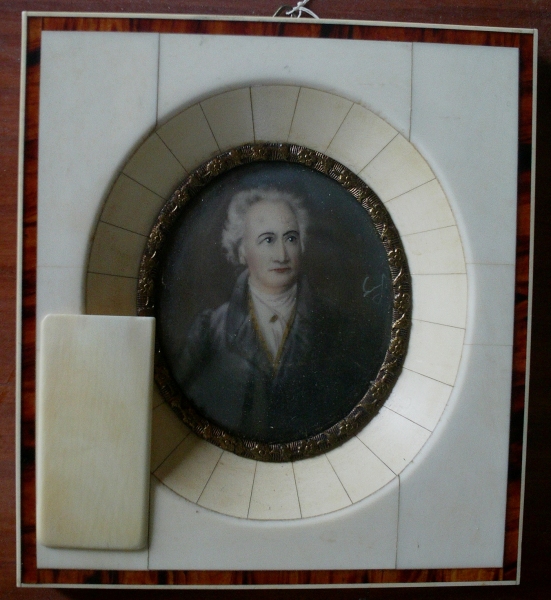



Piano key frames?
The story goes that the ivory frames in which miniature portraits are held, were covered with piano keys of old discarded pianos.
It is a romantic story, but not true for several reasons:
The paintings themselves were made on oval chips of ivory, much larger than piano keys. The artists needed to use “new” ivory for their portraits anyway, so why use “old” ivory for the frames? And the artists were capable of slicing the ivory in very thin layers, sometimes even thinner than piano key ivory. Thus, they had “new” ivory in stock and they had the skills to slice it, so they didn’t need others to provide them with ivory chips.
The sizes of the chips of the frames may look like piano key chips of ivory, but in reality they are often slightly or much bigger. In general their dimensions have no relation to the dimensions of a piano key. On this photo, the piano key is half a millimeter less wide and 12 milimeter less high than the chips of the frame. Note also that the piano keys have rounded edges, which would have to be cut off, by which the difference between the piano keys and the frame chips would even become more prominent.

How many discarded pianos were needed for miniature painting? At the start of the 20th century Haffke produced “ several thousands ” of miniature portraits a year. Let’s suppose 3000 items. But Haffke wasn’t the only producer of miniature portraits. In Germany alone there were several others. Let’s suppose the others all together made 3000 items as well. Then every year 6000 miniature portraits were produced in Germany. For one frame about 10 old keys are needed. A piano usually has 52 white keys. So, one discarded piano could provide enough ivory for just 5 frames. With a production of 6000 portraits a year, the German artists needed 1200 discarded piano’s every year, which equals 4 pianos every day, sundays not included! It is noteworthy that at the start of the century pianos were often the most valuable item in the house and were built to survive several generations. Unlike today, they weren’t discarded easily, but endlessly repaired instead. Even today when pianos are discarded easily because they are replaced by synthesizers and other electronic instruments, it will be hard if not completely impossible to find 4 old pianos every day and one would need an entire infrastructure to find and fetch the ivory of the pianos.
No ads in local newspapers have been found of miniature painters or frame makers looking for old pianos or just their ivory.
It is more likely that old pianos (if not thrown away) were sold to piano repair shops or piano factories which could use the entire piano for spare parts than selling an old piano to a frame maker who could only use the ivory.
CONCLUSION
Just like an orange colored witch hat alongside the road isn’t really a hat that was put there by a witch, a piano key frame isn’t really a frame covered with ivory of piano keys. They just received their names because of some optical similarities.